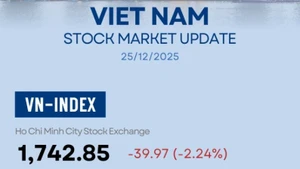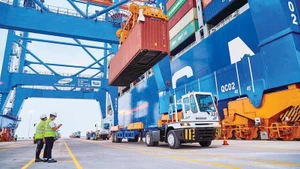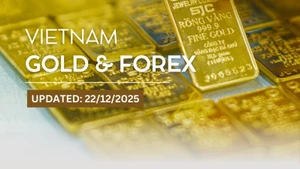A series of construction projects underway nationwide are expected to drive breakthroughs in the building materials market in general, and the cement sector in particular, helping it return to a stable growth trajectory.
Positive signals
According to the Department of Science, Technology, Environment, and Building Materials under the Ministry of Construction, in the first six months of 2025, cement production reached 49.8 million tonnes, up 18% year-on-year.
Total consumption of cement and clinker reached 54 million tonnes, an increase of 14% over the same period, with domestic consumption at about 37.5 million tonnes, up 18%; exports of cement and clinker were estimated at around 17 million tonnes, up 6%. Export value in the first half of the year was approximately 635 million USD, an increase of 1.7% year-on-year. Key export markets include the Philippines, the US, Singapore, and Malaysia.
In the same period, Viet Nam Cement Corporation (Vicem) produced 10.82 million tonnes, up 9.8%; sales reached 12 million tonnes, up 5%, with domestic consumption at 10.09 million tonnes, an increase of 18.4%. Pre-tax profit stood at 1.3 trillion VND.
Acting General Director of Vicem Ngo Duc Luu said that to achieve these results, Vicem closely monitored market developments, coordinated production and sales to design the most efficient kiln operation plans, optimised operations, maintained clinker stock to meet demand, and avoided dumping clinker.
In a market where supply far exceeds demand, competition between plants is fierce. General Director of Xuan Thanh Cement JSC Vu Quang Bac shared that in recent years, when cement sales were sluggish, plants competed by lowering prices, even accepting losses to maintain production. However, since late 2024, the industry has improved, and the Government has introduced comprehensive measures to boost domestic consumption, adjust tariffs, and implement other supportive policies.
Most recently, the export tax rate on cement was reduced from 10% to 5%, helping to revitalise exports and ease domestic sales pressure. The company has begun stable exports to demanding markets such as Singapore and the US under long-term contracts of about 600,000 tonnes per year, earning trust and high evaluations from partners.
Enhancing operational efficiency
Despite many positive signals, cement manufacturers still face challenges.
Input material prices have risen sharply, particularly construction sand, which has doubled or tripled compared to late 2024, causing slowdowns in construction and subsequent declines in cement consumption. Some cement companies also face difficulties in exploiting raw materials.
Nguyen Hai Minh, Deputy General Director of Vicem Hoang Thach, noted that limestone and clay quarries (the main raw materials for cement production) are licensed annually based on plant capacity and can only extract the quantity permitted.
Meanwhile, the process of applying for adjustments to extraction quotas or new mining licences is highly complex and time-consuming, sometimes causing companies to miss business opportunities. Therefore, businesses have proposed more flexible and long-term policies for quarrying raw materials for cement production, aligned with their operational conditions and market signals, especially during the transitional period between the new mineral and planning laws.
To improve cement production efficiency, in addition to technical innovations and cost savings, companies need to accelerate investment in waste heat recovery systems for power generation.
According to Vice Chairman of the Viet Nam Building Materials Association Pham Van Bac, for example, all three production lines of Xuan Thanh Cement Plant are equipped with waste heat recovery systems generating nearly 50 MW, saving about 30% of electricity consumption, equivalent to roughly 100 billion VND per year. In contrast, state-owned cement enterprises have been slow to invest in such systems.
It is also noteworthy that cement producers are increasingly adopting circular economy models and pursuing innovation.
Le Van Ke, Deputy Director of the Department of Science, Technology, Environment, and Building Materials, said the ministry will continue reviewing and adjusting mechanisms and policies to address difficulties in sourcing raw materials, offer incentives for using waste as alternative raw materials and fuels, conserve natural resources, save energy, and protect the environment. The ministry will also explore measures to shut down small-capacity, polluting production lines and restrict new plants or lines in areas already densely populated with cement production or far from raw material sources.
The project to build at least one million social housing units for low-income earners and industrial park workers during the 2021–2030 period, along with other housing construction programmes and projects, needs to be vigorously implemented.
Additionally, the Ministry of Construction will work with localities to promptly address investment approval and land lease procedures for mineral exploitation and cement production projects, and to review provincial planning to align with national planning. The goal for the remaining months of the year is to achieve total cement consumption of about 95–100 million tonnes, up 2–3%.
















